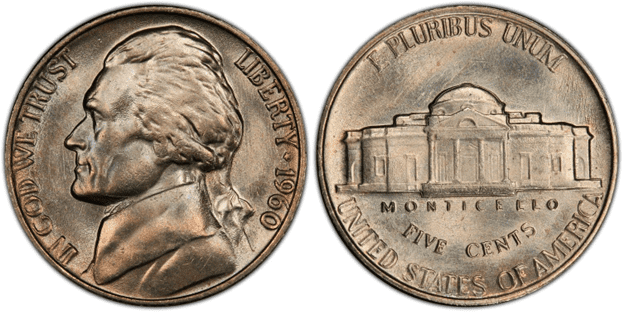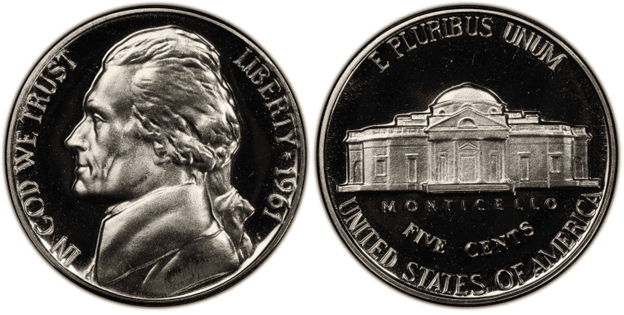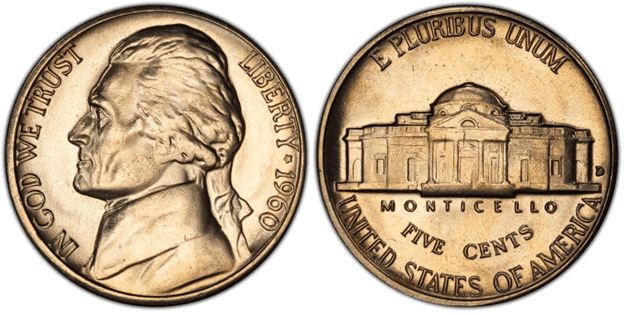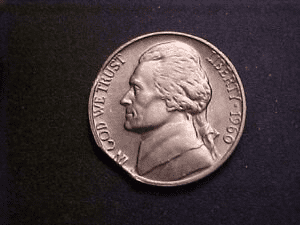What Is the 1960 Jefferson Nickel Made Of?
The 1960 Jefferson nickel is made of 75% copper and 25% nickel. It’s quite interesting to note that from mid-1942 to 1945, nickel was made of 56% copper, 25% silver, and 9% manganese. They were called “Wartime Nickels.”
The change in composition was brought about due to the increased demand for copper and nickel on the battlefield, which were both important raw materials used in World War II.
The face value of the 1960 Jefferson nickel is 5 cents. It has a mass of 5 grams, a diameter of 21.21, and a plain edge.
The first design of the Jefferson nickel’s obverse was made by the artist Felix Schlag. In 2005, the obverse design was made by Joe Fitzgerald. Today, since 2006, the obverse was redesigned by Jamie Franki, and Jefferson’s portrayal is now facing forward.
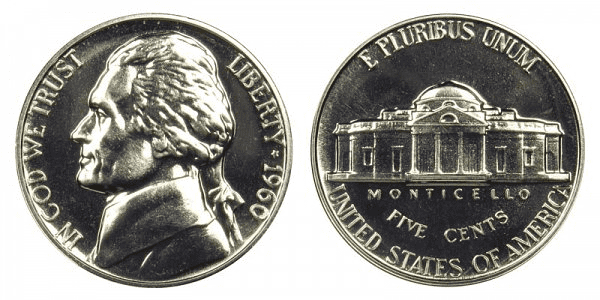
Regarding design, the 1960 nickel obverse features the third president of the United States, Thomas Jefferson. The left side of the coin reads, “IN GOD WE TRUST.” On the right side reads, “LIBERTY,” then the year of minting, which is 1960.
On the reverse, you’ll see the front view of the Monticello, which is the mansion owned by Jefferson. Inscriptions include the following:
- PLURIBUS UNUM
- MONTICELLO
- FIVE CENT
- UNITED STATES OF AMERICA
The Jefferson nickel replaced the Buffalo nickel in 1938. Although the Buffalo nickel features a beautiful design, the US Mint wanted to replace it immediately due to the difficulty of producing it. The Buffalo nickel die often broke. Thus, after 25 years of striking the Buffalo nickel, it was finally retired.
The US Mint wisely chose to hold a design competition for the nickel. Eventually, Schlag won. Although his obverse design was approved with minor changes, his reverse design was completely scrapped, and the US Mint asked him to create a new one.
1960 Jefferson Nickel Varieties
The 1960 Jefferson Nickel comes in three main varieties: 1960 P Jefferson nickel, 1960 P Jefferson proof nickel, and 1960 D Jefferson nickel.
Aside from the standard varieties of the 1960 Jefferson nickels, some have errors in them, giving rise to a different type of coin.
Here are the 1960 Jefferson nickel varieties that you should know:
1960 P Jefferson nickel
Edge: Smooth
Mint Mark: No mint mark
Place of minting: Philadelphia
Year of minting: 1960
Face Value: $0.05 (fifty cents)
Price: $0.05 to $14 (or more)
Quantity produced: 55,416,000
Designer: Felix Schlag
Composition: 75% copper and 25% nickel
Mass: 5 grams
Diameter: 21.21 mm
Thickness: 1.95 mm

photo source: PCGS
The 1960-P Jefferson nickel was struck in the Philadelphia Mint, and there were more than 55 million of these coins. There’s no mint mark, and the average price ranges from $0.05 to $14.00, but some coins could reach hundreds of dollars.
If you are looking for a valuable 1960 P nickel, you need to look for a coin with a “Full Step” grading. This means that when you look at the reverse, you can see 5-6 steps on Monticello’s stairs.
According to PCGS, there are currently no 1960 P nickels with a grade equal to and greater than MS 67.
1960 P Jefferson nickel (proof)
Edge: Smooth
Mint Mark: No mint mark
Place of minting: Philadelphia
Year of minting: 1960
Face Value: $0.05 (fifty cents)
Price: $7 to $50.00 (or more)
Quantity produced: 1,691,602
Designer: Felix Schlag
Composition: 75% copper and 25% nickel
Mass: 5 grams
Diameter: 21.21 mm
Thickness: 1.95 mm

photo source: PCGS
The 1960-P proof Jefferson nickel was also struck in the Philadelphia Mint. At the end of 1960, there were more than 1.6 million P-proof nickel coins.
The mint mark is absent, a tradition that the Philadelphia Mint held. The average price ranges from $0.05 to $78.00.
If you have noticed, there are only about 1.7 million 1960 nickel-proof coins. Proof coins are made for collectors and not for circulation. That explained the low mintage.
Proof coins are more detailed and attractive. These coins are usually bought from the US Mint.
1960 D Jefferson nickel
Edge: Smooth
Mint Mark: D
Place of minting: Denver
Year of minting: 1960
Face Value: $0.05 (fifty cents)
Price: $8 to $16.00 (or more)
Quantity produced: 192,582,180
Designer: Felix Schlag
Composition: 75% copper and 25% nickel
Mass: 5 grams
Diameter: 21.21 mm
Thickness: 1.95 mm

photo source: PCGS
The 1960-D proof Jefferson nickel was struck in the Denver Mint. You’ll find the “D” mint mark between the right side of the Monticello and the edge of the coin. The average price ranges from $0.05 to $78.00. The Denver Mint produced the most number of 1960 nickels reaching more than 192 million.
Like the 1960-P variety, the 1960 D is also difficult to find with the Full Steps (FS) designation. PCGS hasn’t seen any 1960 D FS as of 2014. Possibly, there are less than 50 to 75 coins with a grade of MS 66.
List Of 1960 Jefferson Nickel Errors
There were a total of 249,689,782 Jefferson nickels struck in 1960. With this huge number, it is expected that some of the coins struck may have an error.
One good example is this coin:

photo source: eBay
This coin has a planchet error. Its edge is clipped, which is an error that may have happened during the cutting of the planchet.
Other errors may also happen. For example, the die could break after thousands of times used. When the die breaks, the crack gets engraved as well on the coin.
Another example of a coin error is the off-center strikes. This happens when the die hits the planchet at the wrong angle.
Doubled-die strikes could happen, too. This results in the doubling of some engraved elements, usually letters. Doubled-die strikes can be difficult to detect. However, the more obvious the error is, the rarer and more expensive the coin gets.
How Much Is 1960 Jefferson Nickel Worth Today?
The 1960 Jefferson is worth $0.05, as its face value suggests. Its melt value is not that big as well, which is $0.0616. Looking at the face value and melt value, you might ask, is my 1960 Jefferson nickel worth anything?
The answer is yes if you have a professionally graded 1960 nickel coin. To give you an idea of the potential value of this nickel, here’s a 1960 Jefferson Nickel values chart for you to explore:
| Coin | Condition | Grade | Mintage | Value |
| 1960 P Jefferson Nickel | Circulated/mint | Not graded | 55,416,000
|
$0.05 to $14 |
| 1960 P Jefferson Nickel | Uncirculated/mint | MS-65 | 55,416,000
|
$5 to $460 |
| 1960 P Jefferson Nickel | Uncirculated/mint | MS-67 | 55,416,000
|
$10 to $57 |
| 1960 P Jefferson Nickel | Uncirculated/mint | MS-67 | 55,416,000
|
$1922 to $204 |
| 1960 P Jefferson Nickel (Proof) | Uncirculated/proof | Not graded | 1,691,602 | $7 to $50.00 |
| 1960 P Jefferson Nickel (Proof) | Uncirculated/proof | MS-67 | 1,691,602 | $11 to $253 |
| 1960 P Jefferson Nickel (Proof) | Uncirculated/proof | MS-68 | 1,691,602 | $9 to $40 |
| 1960 P Jefferson Nickel (Proof) | Uncirculated/proof | MS-69 | 1,691,602 | $37 to $105 |
| 1960 D Jefferson Nickel | Circulated/mint | Not graded | 192,582,180 | $8 to $16.00 |
| 1960 D Jefferson Nickel | Uncirculated/mint | MS-65 | 192,582,180 | $7 to $19 |
| 1960 D Jefferson Nickel | Uncirculated/mint | MS-66 | 192,582,180 | $16 to $188 |
| 1960 D Jefferson Nickel | Uncirculated/mint | MS-67 | 192,582,180 | $200 to $384 |
As you can see, some 1960 Jefferson nickels are valuable. Just to give you an idea, a 1960-D nickel was sold for $3,150 on December 8, 2021. It has a grade of MS 67 and was sold on eBay.
Moreover, there’s also a PR 66 graded 1960-proof nickel that was sold for $1,495. The 1960 P nickel isn’t that expensive compared to others, but still, it has an auction record of $460.
How Does The Grading System Work?
The Sheldon Scale is used by numismatists to provide a numerical value to coins. The Sheldon Scale goes from poor (P-1) to perfect mint state (P-1) (MS-70). Coins were originally evaluated using words to reflect their condition (Good, Fair, Excellent, Etc.). Unfortunately, coin collectors and dealers had different ideas about what each of these terms represent.
Professional numismatists joined together in the 1970s and established CoinGrading standards. These numismatists now assign grades at key places on the seventy-point scale, using the most regularly utilized numeric points in conjunction with the original adjective grade. The following are the most common coin grades:
-
-
- (P-1) Poor – Indistinguishable and probably damaged; if used, must have a date and mintmark; otherwise, rather battered.
- (FR-2) Fair – Nearly smooth, but without the damage that a coin graded Poor often possesses. The coin must have enough detail to be identified.
- (G-4) Fair – Inscriptions have merged into the rims in some areas, and important elements have been mostly erased.
- (VG-8) Very Good- A little weathered, but all of the primary design elements are visible, albeit faintly. There is little if any, central detail left.
- (F-12) Good – The item is very worn, yet the wear is even, and the overall design details stand out clearly. Rims are almost completely isolated from the field.
- (VF-20) Very Fine – Moderately weathered, with some finer features still visible. The motto or all letters of LIBERTY are readable. Both sides of the coin have entire rims that are separated from the field.
- (EF-40) Extremely Fine – Gently used; all gadgets are visible, and the most important ones are bold. The finer details are bold and clear, however, light wear may be seen.
- (AU-50) Uncirculated – Slight evidence of wear on the coin’s design’s high points; may have contact marks; eye appeal should be adequate.
- (AU-58) Uncirculated Choice – Slight traces of wear, no severe contact marks, almost full mint shine, and great eye appeal.
- (MS-60) Mint State Basal – Strictly uncirculated; no indication of wear on the coin’s highest points, but an unsightly coin with reduced luster, visible contact marks, hairlines, and other flaws.
- (MS-63) Mint State Acceptable – Uncirculated, but with contact scratches and nicks, little reduced shine, but otherwise appealing appearance. The strike is weak to average.
- (MS-65) Mint State Choice – Uncirculated with great mint shine, very little contact blemishes, and exceptional eye appeal. The strike is unusually severe.
- (MS-68) Mint State Premium Quality – Uncirculated with superb luster, no obvious contact marks to the naked eye, and exceptional eye appeal. The strike is quick and appealing.
- (MS-69) Almost Perfect Mint State – Uncirculated with perfect brilliance, a sharp and appealing strike, and extremely good eye appeal. A near-perfect coin with minor imperfections in the planchet, strike, and contact markings (seen only under 8x magnification).
- (MS-70) Mint State Perfect – Under 8x magnification, there are no tiny imperfections discernible; the strike is crisp, and the coin is perfectly centered on a beautiful planchet. Rarely seen on a coin, this coin is bright and whole, with original luster and exceptional eye appeal.
-
Where To Buy Or Sell 1960 Jefferson Nickel?
You can buy or sell 1960 Jefferson nickel online and in brick-and-mortar stores.
The Internet is a good choice because it is accessible and easy to use. All you need to do is go to Google and search for websites where you can buy or sell Jefferson nickels.
While yes, you can do a Google search, there are specialized websites you can also go to. Some examples would include USA Coin Book, Coin Tracker, and Coin Appraiser, to name a few.
Of course, you can go to online selling platforms, too. The most popular would be Amazon and eBay. These two websites also allow you to sell your coins. You can create an account and start buying or selling 1960 nickels.
Aside from the Internet, you can visit coin shops and antique stores. Pawn shops can also be a good choice. If you have time, you can join auctions where some of the rarest coins are up for grabs.
FAQs
Is there a 1960-D nickel with a sharp bar error?
Yes, there is. The 1960-D nickel has a sharp bar found on top of the number zero in the year 1960.
What does the “D over D” error mean in the 1960 Jefferson Nickel coin?
The D over D error means that the mint mark D was struck twice. The second strike isn’t exactly in the same position as the first strike. This leads to doubling the letter D in the 1960 Jefferson nickel coin.
Where is the mint mark on a 1960 nickel?
The mint mark on a 1960 nickel can be found on the reverse side of the coin. Look for the small letter “D” between the edge of the coin and the right side of the Monticello mansion. Please note that the Philadelphia Mint didn’t add a mint mark. So, you will only find coins with a D mint mark, which indicates that the coin is from Denver.

